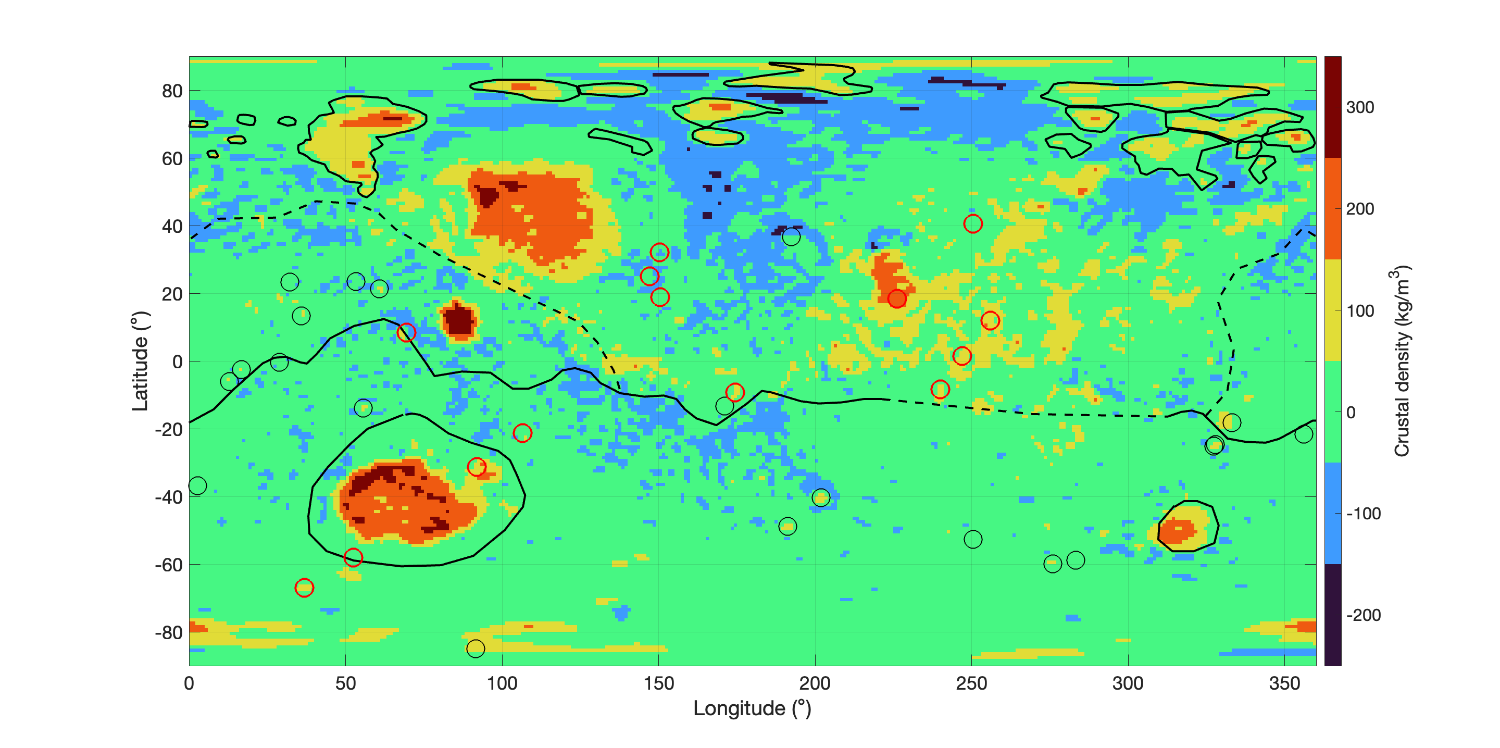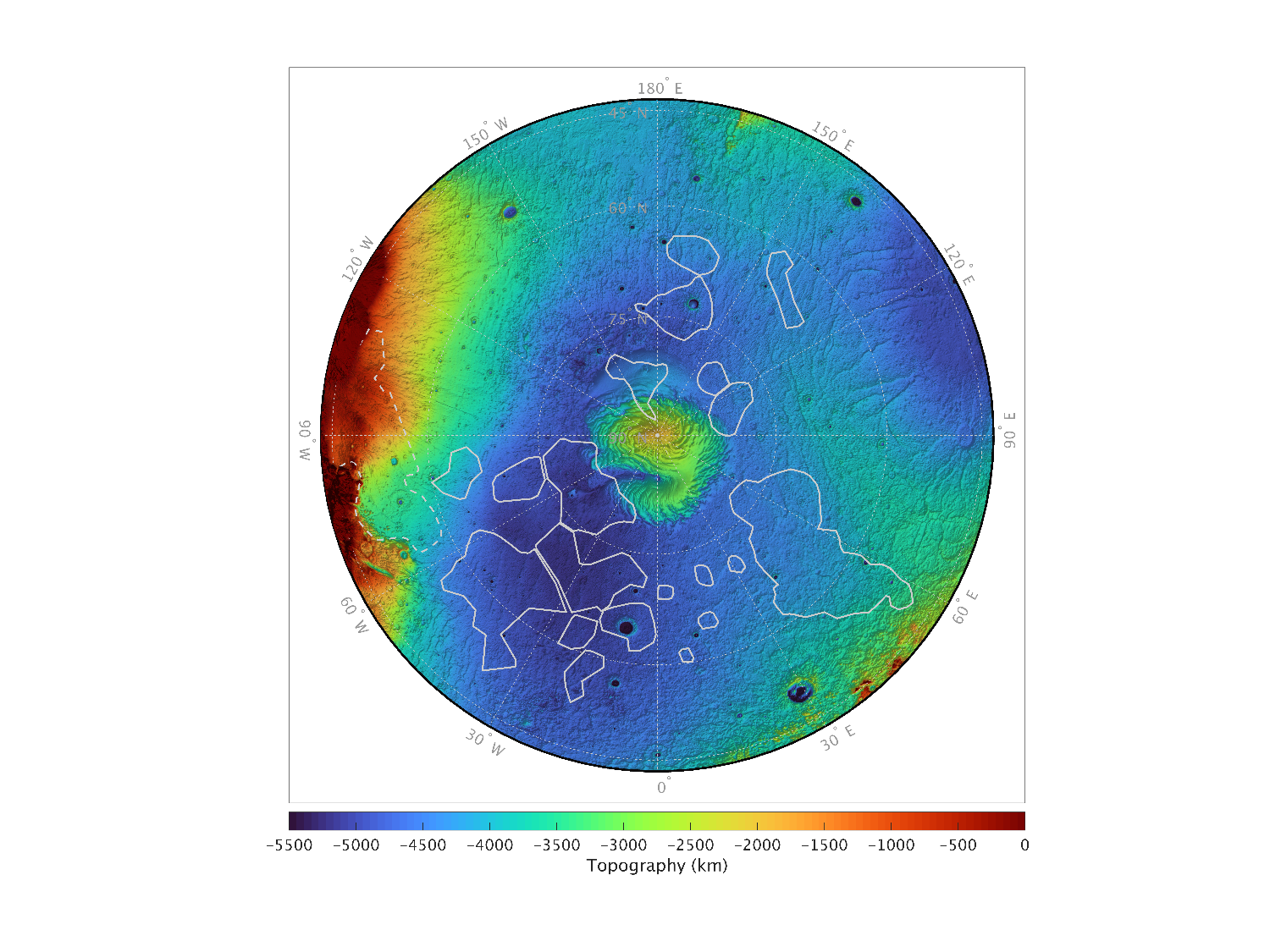Exploration of high mass subsurface structures in the northern hemisphere with joint flexure and mantle convection modelling of the Martian gravity field
- 1Aerospace Engineering, Delft University of Technology, Delft, Netherlands (b.c.root@tudelft.nl)
- 2Civil Engineering, Delft University of Technology, Delft, Netherlands
- 3Geosciences, Utrecht University, Utrecht, Netherlands
NASA’s InSight mission has brought new information about the Martian lithosphere (Banerdt et al. 2020), which warrants a re-analysis of the support of the crustal and sub-crustal masses. Furthermore, the discovery of a possible mantle plume underneath the region south of Elysium Mons (Broquet et al. 2023), gives evidence for recent magmatic activity underneath the crust of Mars causing dynamic support to volcanic structures.
The goal of this study is to combine a global flexural model combined with mantle convection modelling to study the different uncertainties in the geophysical parameters that dictate crustal (short-scale) and mantle (large-scale) mass anomalies. After conducting spectral analysis on the gravitational signal of we found that the Martian lithosphere can be best modelled by an elastic thin shell with the following physical parameters: crustal thickness of 60 ±10 km, crustal density of 3050 ±50 kg/m3, mantle density of 3550 ±100 kg/m3, and the elastic thickness (Te) is found to be 80 ±5 km.

Figure 1: Crustal density from short scale gravity anomalies inversion. The flexural model is not able to represent to perfect isostasy ate Hellas Basin (and assumed present also at Utopia basin). Therefore, high crustal density is seen reflecting a shallower crust-mantle interface. Isidis and Argyle basin also show high mass regions that could be interpreted as shallow crust-mantle boundary or magmatic intrusions in the crust. Other high mass features are related to volcanoes and large impact craters. Finally, the northern polar planes show also anomalous high mass regions.
By using this spectral analysis, we were able to isolate the remaining long-wavelength signal that cannot be realistically modelled by a flexure model. The location of the residual anomaly correlates with the Tharsis Rise, which suggests active large-scale dynamic support of the volcanic region. A negative mass anomaly in the mantle underneath the Tharsis Region explains the remaining gravity residual. This anomaly could be interpreted as underplating of the lithosphere, a phase transition anomaly at 1000 km depth, or an rising mantle plume. Could mantle convection is still be active in Mars explaining the relatively young geologic surface volcanism?
The remaining short scale gravity residuals give insight in Martian crustal density distributions (Figure 1). Flexure models cannot account for these structures as the lithosphere is strong enough to reduce/negate any topographic signature. Especially in the northern polar plains several buried mass anomalies have been detected (Figure 2). The nature of these anomalies is unclear, as they could be interpreted with a volcanic origin, impact related structures, or tectonic orogeny that would all be buried be the sedimentary layer that is observed on the surface of the northern hemisphere. If these structures are interpreted as impact craters this would suggest of an older crustal age of the northern hemisphere of Mars than is now considered. New gravity satellite missions towards Mars are needed to uncover the nature of these subsurface mass anomalies (Wörner et al 2023, Genova et al 2020).

Figure 2: Contours of the high mass anomalies in the nortern polar plains. These high mass anomalies seem to have no topograohic signature. Topography is shown in the colorscale and taken from the MOLA dataset.
References:
- Banerdt, W. B., Smrekar, S. E., Banfield, D., Giardini, D., Golombek, M., Johnson, C. L., … Wieczorek, M. (2020, March). Initial results from the InSight mission on Mars. Nature Geoscience, 13 (3), 183–189.
- Broquet, A., & Andrews-Hanna, J. C. (2023). Geophysical evidence for an active mantle plume underneath Elysium Planitia on Mars. Nature Astronomy, 7 (2),160–169.
- Genova, A. (2020), ORACLE: A mission concept to study Mars’ climate, surface and interior, Acta Astronautica, 166, 317-329.
- Wörner, L., B.C. Root, P. Bouyer, C. Braxmaier, D. Dirkx, J. Encarnação, E. Hauber, H. Hussmann, Ö. Karatekin, A. Koch, L. Kumanchik, F. Migliaccio, M. Reguzzoni, B. Ritter, M. Schilling, C. Schubert, C. Thieulot, W.v. Klitzing, O. Witasse (2023), MaQuIs—Concept for a Mars Quantum Gravity Mission, Planetary and Space Science, 239, 105800.
How to cite: Root, B., Alkahal, R., Qin, W., and Thieulot, C.: Exploration of high mass subsurface structures in the northern hemisphere with joint flexure and mantle convection modelling of the Martian gravity field , Europlanet Science Congress 2024, Berlin, Germany, 8–13 Sep 2024, EPSC2024-730, https://doi.org/10.5194/epsc2024-730, 2024.